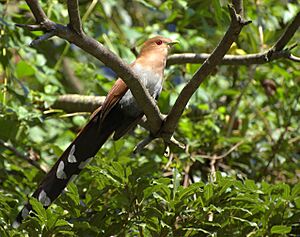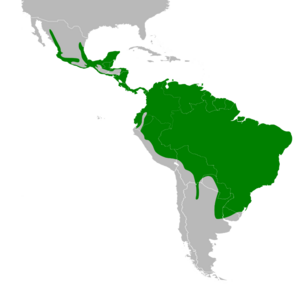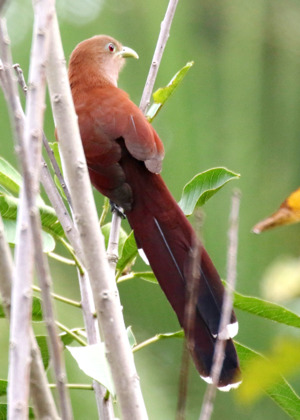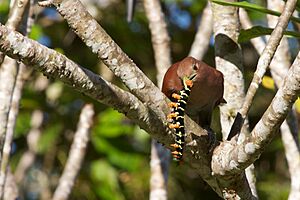Squirrel cuckoo facts for kids
Quick facts for kids Squirrel cuckoo |
|
|---|---|
 |
|
| Conservation status | |
| Scientific classification | |
| Genus: |
Piaya
|
| Species: |
cayana
|
 |
|
| Synonyms | |
|
Cuculus cayanus Linnaeus, 1766 |
|
The squirrel cuckoo (Piaya cayana) is a big, busy bird. It is a type of cuckoo that lives in forests and woodlands. You can find it from Mexico all the way down to Argentina and Uruguay. It also lives on the island of Trinidad. Some experts think the squirrel cuckoos in western Mexico might be a different kind, called the Mexican squirrel-cuckoo.
Contents
What Does the Squirrel Cuckoo Look Like?
This large bird has a very long tail. It is about 40.5 to 50 centimeters (16 to 20 inches) long. It weighs about 95 to 120 grams (3.4 to 4.2 ounces). Adult squirrel cuckoos have a reddish-brown back and head. Their throat is a lighter brown. The lower part of their chest is grey, and their belly is dark, almost black.
The feathers in the middle of their tail are reddish-brown. But the outer tail feathers are black with white tips. They have a yellow beak and bright red eyes. Young squirrel cuckoos have a grey beak and eye-ring. Their eyes are brown, and their tail has less white. This bird looks a bit like the little cuckoo. However, the little cuckoo is smaller and has a darker throat.
Different Kinds of Squirrel Cuckoos
There are several different types of squirrel cuckoos, called subspecies. They have small differences in their feathers. For example, one type from South America, P. c. mehleri, has brown outer tail feathers instead of black. Also, cuckoos from Mexico, Central America, and northern South America have a yellow ring around their eye. But in the rest of South America, this eye-ring is red.
What Sounds Do They Make?
Squirrel cuckoos make loud, sudden calls like kip! and kip! weeuu. Their song sounds like a whistle, wheep wheep wheep wheep.
Where Do Squirrel Cuckoos Live and What Do They Do?
You can find the squirrel cuckoo in forests and along the edges of woodlands. They also live in areas with new tree growth, hedges, and open spaces. They live from sea level up to about 2,500 meters (8,200 feet) high. However, they are not common above 1,200 meters (3,900 feet).
How They Move and Find Food
The squirrel cuckoo got its name because it moves like a squirrel. It runs along branches and jumps from one branch to another. It usually flies only short distances. When it flies, it mostly glides, flapping its wings only sometimes.
This bird eats large insects like cicadas, wasps, and caterpillars. This includes caterpillars with stinging hairs! They also sometimes eat spiders, small amphibians, and reptiles like small lizards. They rarely eat fruit. They usually grab their prey from leaves with a quick lunge. But they can catch wasps while flying.
Squirrel cuckoos are sometimes seen looking for food with small mammals. For example, they might forage with common marmosets during the dry season. They often follow army ants. The ants stir up insects, and the cuckoos catch them. They might also join groups of different bird species that are feeding together.
Nesting and Eggs
The squirrel cuckoo builds a nest that looks like a cup. It is made of leaves on a base of twigs. They hide their nest in thick plants, usually 1 to 12 meters (3 to 39 feet) high in a tree. The female bird lays two white eggs.
Conservation Status
The squirrel cuckoo is common in most places where it lives. It seems to be okay with people being around, as long as there are still some woodlands. Compared to many other cuckoos, it is quite brave and easy to spot. Even so, it often stays hidden in the plants. Because it lives in such a wide area, the IUCN says it is a species of "Least Concern." This means it is not currently in danger of disappearing.





